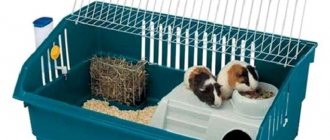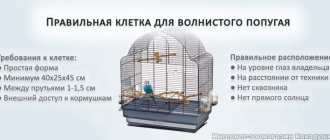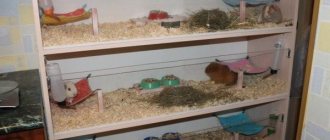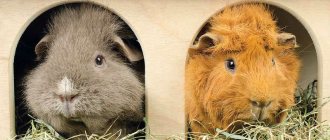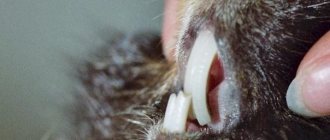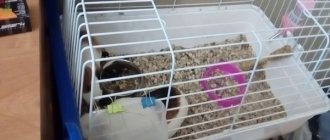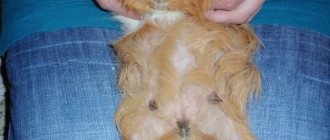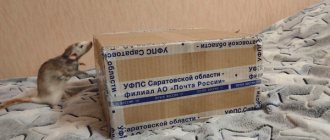Having decided to buy such a wonderful pet as a guinea pig, you need to take care, first of all, about where it will live. It seems that choosing a suitable cage for a guinea pig is not difficult, because today pet stores offer a wide range of different cages from one to three floors with ready-made houses, ladders, manholes, labyrinths and various intricate passages. However, when choosing, you need to be guided not so much by the external attractiveness of your pet’s home, but by its safety and convenience.
What types of cages are there for guinea pigs?
A guinea pig cage can be in the form of an aquarium or terrarium, dune or lattice. But are all types of cages suitable for keeping rodents?
Aquarium
This type of home is a rectangular glass container. Tightly closed walls prevent scattering of filler around the animal’s “apartment” and drafts. But in such a home there is no air ventilation. Animals breathe stale air, pet feces emit a stench, and harmful bacteria multiply faster, which leads to animal diseases.
Therefore, this type of housing is not recommended for pigs.
Dune
Such a home looks more like a plastic container. Its upper part is made with a lattice door, the lower part is blank. The advantages of this type include: cleanliness around the cage, mobility.
Disadvantages: lack of sufficient ventilation, modest size.
A dune-type device is convenient for taking your animal to the veterinarian or for moving. But for permanent housing for the animal, a more spacious option is needed.
Cell
A pig cage is the most suitable option, as it consists of a plastic tray with high walls and a lattice top. The fact that the walls and roof of this type of housing are lattice allows the air inside the cage to constantly circulate. Hammocks, nipple drinkers, and salt stones are also attached to the grates. The disadvantages of such housing include debris around the cage, inconvenience of carrying, and small size.
Aviary
Another type of housing is an enclosure for a guinea pig. Enclosures are fences that limit a certain area. The walls of the enclosure can be made of wood or metal lattice. Such structures do not have a roof or a pallet. Enclosures are good because they have good air ventilation, they can be assembled into the desired shape, and they can be made with your own hands. The walls of such devices must be at least 40 centimeters.
Pet stores sell cages for birds, chinchillas, and hamsters. They are not suitable for pigs. The hamster's housing is too small. The pig will be cramped in such a space and will become depressed.
A two-story cage designed for hamsters and birds is dangerous for pigs. It is difficult for animals to maneuver in such small areas. There is a risk of falling, which can lead to injury to the animal. For pigs, a large cage size is required.
- Cage and equipment
- Microclimate
- Light mode
- False bottom
- Cleaning and disinfection
- Country aviary
- Aquarium
- Prefabricated house
5
Keeping a Guinea Pig
Your guinea pig's cage or enclosure should always be kept clean. This is necessary primarily for the health of the pet.
Cage and equipment
At home, it is best to keep a guinea pig in a large, comfortable cage. It should be equipped with a plastic tray that can be removed and put back at any time without disturbing the animal. The cage should be at least 40–50 cm high and 40–60 cm wide. Housing of this size will provide the pig with the opportunity to freely stand on its hind legs and climb onto the house.
A cage intended for several pigs should be larger in size than the one in which one animal lives. Its width and height can not exceed 40 cm, but the length should be at least 90 cm. It is best if the cage for several animals is divided into two sections: night and day. In the first, covered with wooden shields or paper, the pigs will sleep, and in the second, they will feed and walk.
The cages in which guinea pigs are kept are placed 30 cm from the outer walls and 40 cm from the heating system or heating devices.
If the owner of a guinea pig does not have the opportunity to purchase a cage, he can make one himself. When manufacturing a cage, the following conditions must be observed:
•
the bottom, walls and ceiling must be without cracks;
•
the bottom and walls should be well lit during daylight hours;
•
the bottom area must be sufficient for animals to run on the floor;
•
the cage should be easy to maintain. Have such a height that the animal cannot crawl out.
Cages for guinea pigs can decorate the interior of a children's room
If desired, you can build a small enclosure for your four-legged pet in the garden or on the balcony of a city apartment. Its bottom is carefully lined with paper, hay or sawdust. Sawdust from coniferous trees, despite their pleasant smell, is not recommended. In the corner of the enclosure you can put a house for the animal.
Pet stores sell a variety of cages for rodents.
They consist of a plastic shallow tray and an open, easily removable wire mesh if necessary. An excessively low trough quickly becomes contaminated with food debris, excrement and bedding elements.
You can place a hollow piece of wood, a brick or a flower pot in a cage with guinea pigs, and you can also make a second floor in the house from knots or wooden stepladders. It should be remembered that the animals’ home should under no circumstances be cluttered, since guinea pigs love wide, free space.
It is also undesirable to use a very high trough, since it will be difficult for a curious pig to look out.
Closed containers made of transparent synthetic material, often used instead of a cage, contribute to the greenhouse effect inside the rodent's home, since they are very poorly ventilated.
It is better to use a homemade wooden box with a height of at least 50 cm as a cage for a pig.
In a guinea pig's cage, you must put 2 feeders (one for hay, the other for green food) and a drinking bowl. Feeders installed in cages should be covered with heavy lids that the animal can climb onto if desired.
Buy feeders of convenient design and good quality.
It is best to use ceramic or plastic ones, which are easy to maintain.
Feeders can be retractable, external, or attached to the floor.
As a container for drinking water, it is best to use a glass or plastic automatic drinker, which can be purchased at a pet store.
The guinea pig will not be bored in such a cage
Equipment required for the cage in which guinea pigs are kept
Regardless of whether the cage is in a room or on a summer cottage, its basic equipment is the same. In addition to feeders and drinking bowls, the guinea pig's home must be equipped with a special house without a bottom with a side hole. In it the animal will rest, sleep and hide from the sun or bad weather.
Microclimate
In the room where guinea pigs are kept, it is necessary to maintain constant temperatures (17–20 °C) and humidity. In addition, the room must be regularly ventilated so that the animals do not suffer from a lack of oxygen. In the warm season, you need to ventilate the room, carefully ensuring that there are no drafts; in the cold season, on the contrary, keep warm. To do this, you can insulate the ceilings, floors and walls, and install double frames.
However, it is worth considering that the microclimate of the cage (especially the closed type) is very seriously affected by the population density of its guinea pigs. If there are a lot of them in the cell, the temperature and humidity rise sharply, and the oxygen saturation of the air decreases.
Guinea pigs feel best in a spacious cage.
In addition, when the cage is overcrowded, the free space necessary for the life of the animals decreases. They cannot rest normally and move actively, which undoubtedly affects their health.
The combination of high relative humidity and low ambient temperature has a negative effect.
The air in the room and inside the cage is saturated with evaporation from drinkers and feeders, evaporation of sweat from the surface of the animals’ bodies and the smell of their glands.
High relative air humidity (about 80–85%) has a very detrimental effect on the body of rodents, changing its heat transfer. The fact is that under optimal temperature conditions, 20–25% of heat transfer occurs due to the evaporation of moisture. The saturated environment does not absorb moisture, and the cooling process of the body worsens.
With a poor balance of temperature and relative humidity, guinea pigs become lethargic, lose their appetite, the metabolism in the animal’s body slows down, and they overheat.
All this together can kill the animals.
Light mode
Sunlight plays a minor role in the development of guinea pigs. Science has proven that the light of incandescent and gas-light lamps completely replaces natural sunlight, with the exception of the effect of ultraviolet irradiation.
In nature, guinea pigs are more active at night, so immediately after being caught and placed in a cage, these animals do not require intense lighting. On the contrary, in the light, guinea pigs are inactive, eat poorly, tend to hide and do not leave the shelter until dark. Of course, such a lifestyle will not improve the health of the animals.
In order for the adaptation period to take place in a shorter period of time, the cage should be artificially darkened for most of the day. Over time, guinea pigs will get used to the light and begin to be active during the day, then the owner will be able to observe their behavior or show their pets to friends.
But even after the animals have fully adapted, their houses must be darkened so that the guinea pigs can rest in a comfortable environment.
False bottom
A false bottom is often used in terrariums and aquariums. It is a plastic sheet with many holes, which is installed 2 cm above the bottom of the cage. Its functions coincide with those of the slatted floor. The false bottom allows the pigs to have less contact with their paws with feces and urine, while the need for main bedding almost completely disappears. This bottom allows or actively absorbs moisture, which allows you to save on the purchase of expensive hygiene products.
You can make a false bottom in two ways: take a sheet of thick plastic, in which you drill holes with a diameter of at least 3 mm at a distance of 6 mm from each other.
If the diameter of the holes is smaller, they will constantly become clogged, and if they are larger, there is a risk that the animal’s paws will get stuck in them. Having finished drilling, you need to sand the uneven, jagged edges of the holes with an emery cloth and install a false bottom in the cage on small legs; place a foam polyvinyl chloride mat with many small holes on the floor of the cage.
The resulting soft coating is easy to clean and retains heat for a long time.
Cleaning and disinfection
To prevent various diseases in guinea pigs, cages must be cleaned and disinfected. If the owner does not pay due attention to these two main preventive measures, then the animals will often get sick, and their fur will quickly lose its inherent shine.
It should be remembered that disinfection measures only lead to success when they are preceded by a thorough cleaning of the room in which the animals are kept. The purpose of cleaning is to remove all organic and inorganic debris from the cage where the guinea pigs live.
Experts distinguish 3 layers of mud:
•
structural dirt particles;
•
mud cover;
•
sticky dirt.
During general cleaning, you must remove all equipment from the cage and wash it thoroughly in a soapy solution, and then rinse with clean water and treat with boiling water or a disinfectant.
Cleaning removes the first two layers of dirt and allows the disinfectant to destroy infectious agents.
Before getting guinea pigs, you need to learn how to properly organize the life of pets so that natural hygiene is maintained in the cage, which is an indispensable guarantee of good health and excellent well-being of rodents.
Daily activities for caring for guinea pigs include cleaning the cage and washing equipment. If the bedding in the cage is made of special paper, which is sold in pet stores, then it is enough to change it once every 2-3 days. Experts do not recommend using newsprint as bedding, which contains a lot of printing ink that is harmful to animals.
In the cage where long-haired guinea pigs live, it is recommended to change the bedding daily
It should not be forgotten that if the bedding in a guinea pig cage gets wet, this increases the likelihood of colds in rodents. Therefore, it is best to use highly absorbent bedding and remove wet areas daily.
The shavings are replaced with fresh ones during general cleaning. After each feeding, it is necessary to thoroughly wash the feeders, first removing the remnants of perishable food that the pets have not eaten. Spoiled foods can cause diarrhea or even severe poisoning in guinea pigs.
If guinea pigs are tamed, then it is best to let them out for a walk while cleaning the cage. If they are still just adapting to new conditions of detention, then it is advisable to transplant them into a transport cage or cardboard box.
Greens wither especially quickly and fruits, berries and vegetables spoil. Fresh food and water are given to guinea pigs daily. General cleaning of the cage is enough to do once every 5 days. During this, in addition to such activities as washing the entire cage and equipment, the bedding should be completely replaced. It is best to use for this purpose bedding material in the form of shavings purchased at a pet store, intended for small animals. It is unacceptable to use peat as bedding, since its smallest particles can contribute to the formation of granulomas in the lungs of guinea pigs. Wet peat will stick to animal fur.
During general cleaning, pets can be let out to walk around the room.
Before replacing the bedding, you should thoroughly wash the cage with a cleaning agent or disinfectant (you can also use vinegar essence), and then rinse it well with clean water. When the cage is dry, you can lay out new bedding.
During general cleaning, you need to clean all existing shelves, seats and roofs of sleeping houses from dry lumps of feces with a small brush. If animals stain seat boards or branches with excrement, they should be washed with hot water and soap, disinfected, and then rinsed with clean water and dried.
To disinfect the cage and equipment, you can use bleach or other disinfectants.
Animal hairs stuck to the cage bars can be easily removed with a damp cloth.
Before disinfecting a room for guinea pigs, you need to do a dry and then a wet cleaning. After wet cleaning, all surfaces, as well as equipment, must dry, as water can reduce the concentration of the disinfectant and also cause unwanted chemical reactions.
It is worth noting that you cannot use strong chemicals to treat cells, their equipment, and inventory. Such remedies are used only as a last resort, for example when parasites are detected.
After treatment with a disinfectant solution, the cage must be thoroughly rinsed with clean water.
Country aviary
When going to the dacha or village in the summer, guinea pig owners often take their pets with them. To do this, it is not necessary to bring the animal’s usual cage from the city, since you can quickly build a new one using available materials. It must be at least 50 cm in height, and 100 cm in length and width.
The enclosure for guinea pigs must maintain sanitary and hygienic conditions that meet the needs of the animal. Mice and other rodents should not be allowed to enter the pigs' home.
The country enclosure is a large wooden cage. Its front wall is made of fine-mesh metal mesh, and the floor is made of wooden slats forming a fine lattice. A tray is installed under the enclosure to collect excrement and food waste.
The dacha enclosure should have a grass feeder and a drinking bowl. The first is made from wire, and the second is cut from a plastic bottle so as to form a small transparent funnel, which is attached to the wall of the enclosure with wire. A drinking bowl is inserted into it. A little below its base, in the wall of the cage, a window is made of wire for the spout of the drinking bowl.
There can be 2 feeders in the enclosure: one for grass, and the other for solid bulk or liquid food. It is this feeder that the animal can easily knock over by pouring food into the tray. This can be prevented by drilling 4 holes equidistant from each other in the walls of the container and inserting into them 2 rigid wires 20–25 cm long, bent in the shape of the letter “P”.
Aquarium
In addition to the cage, an aquarium may be suitable for the guinea pig’s home; it will not make noise in it at night. If you cover the top of the aquarium with a breathable mesh, other animals will not be able to reach the furry animal. In addition, the aquarium solves problems with sawdust scattered on the floor. This is probably where the advantages of the aquarium end; it has many more disadvantages:
•
the aquarium is more difficult to clean because it is quite heavy and can be accidentally broken;
•
the aquarium is poorly ventilated because air enters it only from above, so carbon dioxide and a specific smell accumulate inside. But the problem of poor ventilation can be dealt with if you buy a fairly wide (width should be approximately equal to the length) and not too high aquarium, and cover it with a grill or mesh on top.
•
In the aquarium, the guinea pig will have little space to operate. But the owner will be able to observe her behavior, although jumping on her hind legs onto the wall of the aquarium is not as exciting as climbing the bars of the cage. But if the animal can reach or jump to the net stretched over the aquarium, it will begin to perform acrobatic exercises, just like in a cage.
If a cat lives in the house, it is best to choose an aquarium as a home for the guinea pig, which should be covered with glass with holes drilled in it for ventilation. To prevent the cat from moving the lid off the aquarium, you need to put something heavy on it, such as cobblestones or stacks of books.
Most of the time, the guinea pig will travel upside down along the ceiling of the aquarium, trying to chew through the mesh or bars to get out. To prevent this from happening, you should not cover the aquarium with a grille with rods made of soft metals (copper, aluminum). The animal will gnaw through it literally in one evening.
The mesh or lattice must be securely attached to the frame or bottom of the aquarium. The top of the grate can be pressed down with heavy cobblestones placed in the corners. The guinea pig looks very fragile in appearance, but in fact this animal is quite strong.
And one moment. Before you decide where to place your guinea pig - in a cage or an aquarium - you need to think about which sound will irritate family members less: the rattling of a wheel on the metal bars of the cage or on the wall of the aquarium. It will not be possible to place a wheel in the middle of a guinea pig’s home, because the animal will still move it to the wall.
Instead of cobblestones, you can put a stack of books on the mesh of the aquarium, but in this case the animal will try to chew through them in order to get free. If the owner has unnecessary books, he should not fill the lid with them completely, otherwise the animal will simply suffocate.
Prefabricated house
In some pet stores, special prefabricated houses for rodents have appeared, which consist of several plastic containers connected to each other by pipes made of a similar material. This structure is built like a real underground burrow.
At first glance, it may seem that such a home is ideal for guinea pigs. But it in no way reminds the animals of a mink, since it is made of smooth transparent plastic. They don't really like to crawl on slippery plastic walls. In addition, these houses are very poorly ventilated, even worse than aquariums. They consist of many chambers, the bottom of which cannot be filled with sawdust. As a result, when animals are kept in such houses, a specific smell appears very quickly.
Under no circumstances should guinea pigs be kept in a glass jar or in a round aquarium.
Table of contents
Guinea pig cage size
Pigs are very active animals. They need to exercise a lot to maintain good physical shape. Therefore, large cages are suitable for them. City apartments may not always allow for a large space for a pet. Veterinarians recommend setting aside at least one square meter of space for each pet. It is also necessary to take into account the height of the “ceilings” in the rodent’s home; the height of the walls must be at least 40 centimeters so that the animal can stand on its hind legs.
If the size of the living space does not allow you to provide the required size of housing for the rodent, then you can get by with a small cage in which the pig will rest at night. During the day, the animal is released into a specially fenced and prepared space so that it can run around to its heart’s content. At the same time, the animal must have access to food, water and a sleeping place.
If you have a summer house in the summer, it will be useful for the animal to spend time in the fresh air. Owners set up enclosures in their summer cottages and let their pets out to frolic on the grass.
Choosing the right pet store
Let's imagine this situation. You walk into your local pet store and see an adorable guinea pig that makes your heart melt, and then you notice that the cute animal is huddled in a small glass aquarium with four other rodents.
You, of course, will think that by buying the animal you like, you will save it from such maintenance. In fact, your best bet is to leave this store that treats animals this way. Supporting such outlets is a common mistake of novice owners.
As a rule, to keep rodents they use small aquariums that are not suitable for keeping guinea pigs, as well as other rodents, which are small even for one animal, and they accommodate up to five “tenants” at a time. Naturally, in this case the pigs may not be in the best condition.
Scientists admit the existence of life in subglacial Antarctic lakes
Forgiveness Sunday: rituals and traditions of this day
Free, no time for yourself: Shepelev talked about personal space in the house
Find a large pet store where animals are kept in decent conditions and have a veterinarian who can advise you on how to keep such a pet.
Design
The pet's housing should be spacious and safe, and it should be convenient for the owner to clean the cage and remove the animal from the outside. Single-story structures with solid shelves and ramps are suitable for pigs. Lattice surfaces are not suitable as paws can get stuck in them. The bottom of the device is a plastic tray, which is attached to the lattice top with special latches. The fastening must be strong so that the structure can be moved with the pet inside. If there is no room in the cage for a shelf, then the roof of the rest house can serve as its role.
So that the owner can easily reach the animal without injuring it, a wide door is needed.
It is recommended to choose a distance between the rods of about 2.5 centimeters. Such gaps will prevent the animal from getting stuck. Before use, you must check the structure for sharp corners and crevices. If they exist, they are eliminated, as it is dangerous for the animal.
The place where the pet will spend most of its time should be quiet and calm, hidden from sunlight and drafts. If a pet lives alone, then its housing is placed in a place from which the pet observes the life of family members.
Types of enclosures for pigs
In the summer, experts recommend releasing pigs onto the grass, giving them a little freedom. Ideally, summer residents will be able to do this by taking a portable enclosure with them. If you don’t have money for an enclosure, you can drive small pegs into the ground and stretch a tight mesh. Despite the simplicity of such a structure, an enclosure of this type will not protect your pet from uninvited guests. The greatest danger comes from cats, dogs and birds of prey flying past. If the pig is in an enclosure without a cover on top, it must be under constant supervision.
Enclosures have different internal designs. For the convenience of the animal, you can build tunnels and indoor labyrinths where it can hide from danger. Additions are most often constructed from balsa wood or oak. Bridges can be made from tree bark; they increase the endurance of animals. In the pen itself, you can place additional equipment in the form of toys and other accessories at the owner’s discretion. The floor of the enclosure should be equipped with linoleum or absorbent film. Pieces of an old rug will do. Do not forget that the cage needs periodic cleaning.
Do not give your animal plastic objects, feeders or drinking bowls. Your pet may chew on such objects and injure themselves on the edges of the bitten plastic. Walking for your pet can be organized using a purchased ladder.
Country type enclosure
In the summer, many owners take their pet with them to the dacha in the summer. To make the animal comfortable, you can build a special country-type enclosure. The enclosure is built according to the previously agreed method - stakes are driven into the ground and the net is stretched. You can also pull it on top for greater safety for your pet.
An aviary of a more reliable design is usually made of solid wood. From the outside it looks like a box without a top. It can be attached if you want to protect your pet from uninvited guests like birds of prey, but then you should take care of ventilation. It is distinguished by its spaciousness and proper insulation using special means. The bottom is retractable, which ensures comfortable care by the owners. The surface of the box should be treated a couple of weeks before departure with a protective agent that will prevent rotting and the appearance of various bacteria and putrefaction, and will also protect from moisture.
It is important to remember that you only need to treat the outer part of the enclosure, since the pig may begin to chew on the wood and be poisoned by chemicals. Usually the pen is left in the shade of trees, but if it starts to rain, the pet should be brought into the house
Materials
Three types of materials can be involved in the production of pig housing.
- Plastic.
Durable material from which pallets are made. It is easy to clean and does not react with liquids. But it scratches easily and loses its appearance over time.
- Metal.
Grates are made of stainless steel. They are durable, do not absorb odors and are easy to clean.
- Tree.
Partitions for the enclosure and shelves are made from wood. This material is safe, but it has disadvantages. Wooden parts absorb odors and are difficult to clean. Pets wear down their teeth on wooden objects, which leads to an unpresentable appearance or complete disappearance of the wood.
A tarpaulin is used as flooring in the pet's cage. It needs to be caged to protect surfaces. This material does not absorb moisture, is easy to clean and takes up little space during storage.
Features of feeding
Under natural conditions, guinea pigs eat only plant foods. They eat dry and fresh grass, plant seeds, vegetables, as well as branches of trees and shrubs. Approximately the same diet should be prepared for a pet.
Optimal diet and feeding rules
In order for a pet to delight its owners with its presence for many years, you need to take care of good nutrition. Experts give the following recommendations for feeding guinea pigs:
- Regular distribution of food. The digestion of guinea pigs is amazing. Food moves further through the intestines only due to the arrival of a new portion. If you feed the animal irregularly, stagnation will occur, which will lead to irreversible processes.
- The basis of a guinea pig's diet is hay. Its share of the total food volume is 50%. Dry grass is roughage that promotes good digestion.
- Clean drinking water should be available to your pet rodent at all times.
In addition to hay, pigs eat vegetables, fruits and fresh herbs. The share of succulent food in the rodent's diet is 20%. You can give purchased grain mixtures 1 tablespoon per day. The menu must include branches of fruit trees. There should be a salt lick stone in the cage. With its help, the animal satisfies the need for minerals.
As useful supplements, pigs are sometimes given a small amount of nuts - peanuts, hazelnuts, walnuts. Occasionally you can treat your pet with berries - strawberries, cherries, as well as dried apricots and raisins.
Prohibited Products
Some rodent owners think that nothing bad will happen if they treat their pig with something tasty from the human table. The list of treats often includes foods whose consumption can cause serious health problems.
These include any food of animal origin:
- meat;
- fish;
- eggs;
- cottage cheese;
- milk.
It is forbidden to give guinea pigs sweets, pastries, sausages, beans, garlic, onions and mushrooms.
Those who make their own hay for rodents need to have a good understanding of herbs. Some types of plants are contraindicated for animals:
- wild rosemary;
- hawthorn;
- bindweed;
- burdock;
- sorrel;
- spinach;
- lilac;
- chestnut;
- stems and inflorescences of dandelions.
Attention! Do not feed your pig rotten or moldy vegetables. This can lead to poisoning and even death.
Popular manufacturers
Pet stores sell devices from different manufacturers. They are designed to suit a specific budget and needs.
Popular designs for pigs are the product of the Russian company Triol. The company offers a wide range of accessories and household items for small rodents. The devices are of high quality; stainless steel grilles are covered with enamel. Some models are equipped with a lattice bottom for better ventilation. Such a cage for a guinea pig costs from 1,500 to 5,000 rubles.
The Italian company Ferplast produces wooden, metal and plastic housing. The structure is made in the form of a wooden base with lattice walls, or a lattice top with a plastic tray. The bars of the grill are coated with a mixture that protects the grill from your pet's sharp teeth. Models of such designs are equipped with shelves, ramps, and additional trays for the street. The cages of this company have folding door-walls, which makes cleaning easier.
ferplast cages are equipped with additional accessories necessary for a pet to live a comfortable life.
The price of such a home ranges from 3 to 5 thousand rubles. Convenience and comfort are more important than the price of a cage in which the pet will feel great.
The Midwest company produces housing for pigs that is more similar in design to enclosures than to cages. A canvas bottom is attached to the lattice walls and roof below. This design is easy to clean, has a spacious area and includes partitions and ramps.
The design of sections allows you to transform the enclosure for outdoor keeping; you can also connect several structures together and create a large enclosure.
The cost of the enclosure is about 6,000 rubles.
Belgian dune and cage manufacturer savic offers convenient cages with hinged doors. This makes it convenient to take out your pet and clean the tray and interior items.
Manufacturers of Italian imac cages offer comfortable designs made from quality materials. The structure is made of plastic. The interior of the home is equipped with a shelf and a ramp. There are doors in both the walls and the roof. The cost of such a device is from 4 to 9 thousand rubles.
The number of options for ready-made designs for pigs provides a lot of possibilities. But you can also make a cage yourself. This will allow you to take into account the specific conditions of keeping the animal and the possibilities of the premises.
The cost of a guinea pig cage may be lower if you buy the device secondhand. Often, housing for a pet is given away along with the pet when the previous owner is allergic to wool. You can find very cheap cages on pet owner forums and websites selling used items.
Cells - pros/cons
Each individual cage has its pros and cons, for example, a covered surface made of transparent plastic - such a house retains heat well and at the same time it is poorly ventilated. An aquarium-type section protects well from ventilation, on the other hand, an open top can cause an unpleasant odor in the room. Speaking about all the pros and cons of terrariums for guinea pigs, it is important to take into account the factor of individual significance - this means that a rodent belonging to a certain breed will take root differently in a particular terrarium, accordingly, the cage needs to be selected. In order for a pet to be able to spend time normally in a cage, it is necessary to thoroughly learn about its habits, habits, how susceptible it is to a small space, and based on detailed information, an appropriate terrarium is selected.
How to make it yourself
A homemade cage has a number of advantages:
- Use of environmentally friendly materials.
- Less money is spent on consumables.
- The design and dimensions of the device are suitable for the individual parameters of the room in which the pet will live.
Recommended dimensions for the base on the short side are 70 cm, on the long side 100 cm. For two pets, the long side should be at least 140 cm, for three – 170 cm, for four – 210 cm. The height of the roof should be at least 40 cm.
To make a cage you will need:
- Knife;
- cardboard;
- a simple pencil;
- ruler;
- lattice;
- scotch;
- screeds.
Production begins with markings on straightened cardboard. A base with the required parameters is drawn on it, leaving an additional 15 centimeters on each side. Using a knife, make shallow cuts along the lines of the drawing. Then the cardboard is covered with tape, gluing the strips tightly to each other or overlapping. Then the sides are raised at the cardboard base, which must be secured with tape.
The pre-prepared lattice is cut according to the parameters of the base and assembled, fastened with ties. The resulting structure is inserted into a cardboard base. Housing is ready.
It is recommended to choose the width of the grille gap at 2.5 centimeters. This will allow the paws not to get stuck, but it is also impossible for the animal to crawl through such a gap.
It is recommended to equip your guinea pig's cage with partitions, shelves and other devices for entertaining the animal. Shelves and ramps must be made of wood. Stoppers need to be attached to the edges of these elements so that the pet understands where the surface ends.
How to properly arrange your home
Having decided on the choice of house, you can begin to arrange it. It is necessary to place everything necessary to provide the basic needs of the guinea pig.
The room must have:
- drinking bowl;
- feeder;
- tray with filler;
- bedding made of tarpaulin or sawdust.
To make your pet's life interesting and varied, you can place a variety of accessories in its home. For movement, wooden shelves connected by a ramp can be attached to the walls.
We recommend learning how and what to play with guinea pigs.
You can also place a wooden mini-shelter in a secluded corner. The animal will rest and sleep in it. All sorts of toys will not be superfluous. But at the same time they must be made of organic materials. Plastic accessories for rodents are not allowed.
Where to place the cage
To create conditions for a comfortable life, a pig needs a certain temperature regime, the absence of cold air flows, close proximity to heating devices and sunlight. Heating and air conditioning should not be located closer than half a meter from the pet's cage.
In the room where the pet lives, the air temperature is set at 18 to 20 degrees, humidity – 50%.
The pet’s home should not be placed close to the wall; a distance of 30 centimeters should be left.
Pigs are quite shy animals; constant loud noises can cause them stress. Frequent stress leads to depression. Therefore, the animal must live in a place where there is no TV, loud barking dogs and other noise stimuli.
In addition, the room should be bright, with good air circulation. It is recommended to regularly ventilate this room, but do not allow your pet to be exposed to a draft. To do this, the pet and its housing are placed higher, on a table or on a rack, or taken to another room for ventilation.
The pig's home should not be placed in a room with freshly painted walls, cooking smells, a smoking room or a room adjacent to it, since strong odors are also uncomfortable for the pigs. The room in which the animal will live should be bright, but direct rays should not fall directly on the pet’s home. Since the animal quickly overheats. This is harmful to his health.
Incorrect covering in the cage
There are several options for keeping guinea pigs. But the main rule is not to keep rodents on bare corn or wood filler. Sprinkle it with fine sawdust or cover it with a PVC mat. Some owners cover the floor with diapers and sprinkle sawdust on top, which is also not prohibited. It is important that the animal is not on pellets, which cause wounds on the pigs’ legs that do not heal for a long time, or on a bare floor.
You can use ready-made fleece coverings. Such bedding is inexpensive. Using this material will make daily cleaning of the cage easier. Your pet will feel very comfortable.
Children with COVID-19 coronavirus infect others for 10 days
The name should emphasize character traits: what to name your baby in 2021
At what moments do different zodiac signs become cruel and heartless people?
Setting up a guinea pig cage
If the pet’s home is small, then the necessary minimum of “furniture” is installed in it: a drinking bowl, a feeding trough, a hay barn, a tray, a house. Animals love space and to run around, so you shouldn’t clutter up a small space with unnecessary accessories. If the space allows you to place additional accessories and entertainment, then this will not hurt the animal. These include stairs, shelves, houses, labyrinths. It must be remembered that all these elements must be safe for the animal.
To save space, it is better to purchase drinking bowls and hay bars that are attached from the outside. There are models with retractable feeders. If the feeder is placed inside the cage, it is better to choose heavy ceramic models with a wide bottom or containers that can be attached to the grid to avoid tipping over.
It is recommended to choose a house with two openings for entry and exit to make it more comfortable for the animal. Also, for ease of cleaning, the house should be chosen without a floor. A holiday home with a flat roof will function as a shelf if a safe ramp is connected to the roof.
Proper arrangement of the cage will ensure a comfortable life for the animal, and will also allow the owner to easily restore order in the house.
Be sure to add filler to the bottom. It must be changed regularly to prevent moisture from accumulating at the bottom and to prevent the growth of unwanted bacteria.
A large number of types of housing for rodents in pet stores allows you to choose the most convenient for a particular case. If you need a completely unusual option, then you can make such a design yourself. In any case, it is necessary to proceed from the requirements of keeping a pet so that it lives a long and happy life.
Is it possible to keep a pig in a regular plastic box?
Such a large rodent cannot be kept permanently in an ordinary box made of cardboard or plastic. It is uncomfortable for the animal to live in these containers: there is little space, poor ventilation, and there is no contact with the outside world. In addition, this is an excellent place for the development of bacteria that are dangerous to health. Boxes can only be used for transporting animals.
Did you know? Guinea pigs love company. They are very happy when they live as whole families and do not experience a shortage of human attention.
What types of enclosures are there?
Enclosures can have different “interiors”. You can make some kind of tunnels and pipes so that the animal can run and hide through them. This is often made from cork oak. Guinea pigs enjoy a variety of bridges. They can be made from bark. Ceramic toys and wicker baskets can be placed in the pen.
It is better to place an absorbent diaper on the floor in the enclosure. Old linoleum will do. You can throw on pieces of an old natural rug. Don’t forget to sanitize all this in a timely manner.
You can organize a walk for your guinea pig using a fence purchased from a pet store.
Say no
Although guinea pigs are somewhat unpretentious, this does not mean that they can live anywhere. You cannot place such a pet in a cardboard box or glass jar and think that he is comfortable there.
Aquarium or terrarium
Aquariums and terrariums are absolutely unsuitable for guinea pigs due to the lack of normal ventilation. Animal waste products emit ammonia fumes. In such “housing” they are simply forced to breathe polluted air that poisons their body.
The world behind the glass is not perceived as real for these animals. They don't participate in life behind the glass, so they feel lonely.
Article on the topic: How to make a house for a guinea pig with your own hands at home - drawings and photos
Cage for mice and hamsters
Cages that were previously needed and purchased for mice or hamsters are also not suitable for guinea pigs. They are too small for such large rodents. When purchasing, keep in mind that they not only need to sleep in their house, but also eat, eliminate and have fun. It is due to lack of space that the pet may begin to chew on the cage.
Plastic container "Dune"
The Dune container is designed to contain small rodents. It is equipped with everything necessary for hamsters and gerbils. But guinea pigs are too big for him. In addition, despite the transparency of the plastic, they feel there, just like in an aquarium - lonely.
Instructions for making a fabric house
A fabric tent must have a metal frame base. The metal mesh is bent and covered with a fabric cover. It is recommended to use nylon or fleece. Nylon is easy to clean. Your pet will love fleece for its softness and warmth. Cardboard is sometimes attached to the mesh. These are the future roof and side walls of the house. You can use another piece of fabric as the back wall. Fleece or other bedding is placed at the base of the fabric tent. The fabric tent has many color options, is lightweight and easy to clean. But this option is short-lived, since the animal can chew it off. And then you will have to re-cover the structure with fabric.

